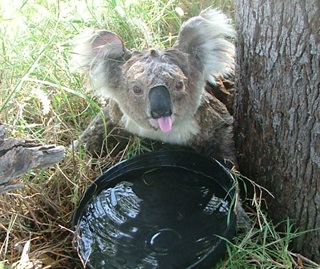During an emergency, government staff and wildlife rehabilitators prioritise effort by focusing on the rescue of injured animals and assisting animals in distress.
It is difficult to fully assess the impact on koala populations until after the crisis has passed and it is safe to enter affected areas.

During extreme events, you can provide water for koalas.
If you find an injured or distressed koala
Koalas are tree dwellers who feed at night. If their habitat has been severely impacted by fire, or if you find a koala on the ground at the base of a tree or it is not moving, then it may be sick or injured. Call a licensed wildlife rescue and rehabilitation provider for advice. Licensed providers are permitted to take distressed or injured koalas into care. You can use the IFAW Wildlife Rescue App to quickly find the closest licensed carer to contact.
Despite their cute appearance, koalas are wild animals and can be dangerous when approached or if you try to catch or handle one. After speaking to a trained wildlife rescuer, you may be asked to try and carefully restrain an injured animal if it is on the ground as you wait for the carers to arrive. If the koala is not handled carefully, it can harm the animal further or cause injury to you with its teeth or sharp claws. Assessing if it is safe to do so, approach the koala from behind and place a washing basket, or a similar item with ventilation, over the animal. Put something heavy on top of the basket to stop the koala moving away and climbing a tree.
If you have been advised to take an injured koala to a wildlife carer or vet, calmly approach the koala from behind to put a thick towel or blanket over it, including its head. It should only be picked up from behind, under its front forearms, with the towel still over its head and the claws clinging to the towel. Place it gently into a ventilated plastic dog carrying container, or if one isn't available, a plastic garbage bin with holes punched in the lid. Do not use a wheelie bin. Transport it quietly and out of direct sun. Do not give it food or water unless advised to by the licensed wildlife carer.
Providing food
Leave it to the experts. Koalas are very fussy eaters and prefer to select the leaves they eat on their own. Not all bush is koala habitat and not all gum trees are the same. Although koalas live in eucalypt woodlands and forests, the specific trees a koala likes to eat from vary between different koala populations, from region to region and even from tree to tree.
It takes a koala expert to know which tree a koala needs from area to area. Their home range can vary in size from less than 2 hectares to several hundred hectares, depending on the type and number of trees available. A single koala can eat up to one kilogram of leaves each day or around 10% of its body weight.
When in care, koalas are left with fresh leaves to choose from, selected and cut by wildlife experts. Only trained wildlife carers have the expertise to provide a healthy and balanced diet to koalas in care. Food for koalas can only be provided under expert direction. You can only collect fresh leaves if you have the permission of the landowner or manager, such as the National Parks and Wildlife Service, Forestry Corporation, local councils or Crown land.
Providing water
Koalas usually source their water through their food. However, during times of fire or prolonged drought, the quality and amount of moisture in eucalypt leaves decreases, so koalas may seek sources of water to rehydrate. When there are few natural water sources, it may be beneficial to provide a suitable water source.
During these times, the Department of Climate Change, Energy, the Environment and Water works with wildlife rehabilitation groups to plan and coordinate the placement and maintenance of drinking stations in affected areas.

The department works with wildlife rehabilitation groups to organise drinking stations.
During extreme events, if you have a koala on your property, you can provide a shallow dish with clean water replaced daily. Secure it in the tree fork or near the tree they are seen in. You could even try building your own koala drinking station using the Providing water for koalas fact sheet (PDF 9.35MB), developed by Northwest Local Land Services and the University of Sydney, as a guide. Never add sugar or electrolytes to the water provided as this can be harmful. Clean the bowl regularly to avoid contaminants and reduce the risk of disease.
Although many images of people giving water to koalas directly from a bottle have been shared on social media, it is important to remember that this is not safe for koalas. Koalas naturally lap up water with their tongues, so any container providing water should allow them to be able to lap it up. Pouring water directly into a koala's mouth can result in water entering its airways and cause pneumonia, which may be fatal.
A swimming pool can present a drowning danger to a thirsty koala. Install steel fencing and trim overhanging trees to stop a koala climbing in. Keep your pool covered or secure a flotation device to the side of the pool, such as a rope threaded through a pool noodle, to help it escape if it falls in while drinking.
Check the pool daily.
More information
- Koalas are a threatened species in New South Wales and, as such, are part of a conservation program called Saving our Species.
- Go to Understanding the impact of the 2019–20 fires.